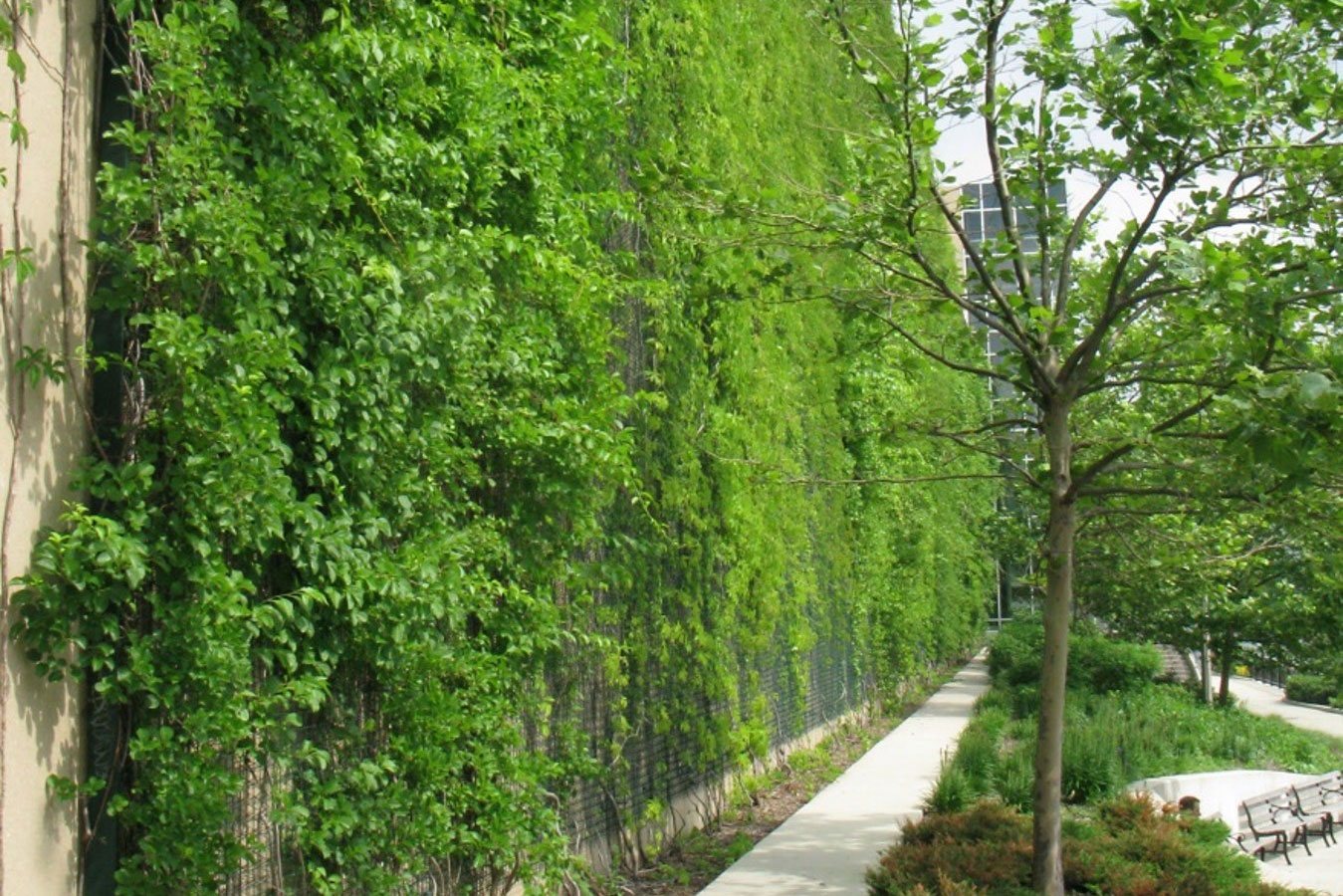Story at a glance:
- Urban greening is critical for a healthy, sustainable, and happy urban life.
- Green infrastructure ranges from simple climbing plants to complex high-tech smart green roofs.
Why is the history of green infrastructure important?
Green infrastructure (GI) history dates back thousands of years with convergent evolution in multiple cultures. Green roofs and facades are not only beautiful but have provided humanity with plentiful ecosystem services that have supported our lives and well-being. Our long history using green infrastructure shows how humans have relied on plants to create spaces where we thrive and prosper throughout time.
Despite the long history of GI, it is often assumed green walls and roofs are recent inventions. Unfortunately this historical oversight may lead to a failure to understand how critical urban greening is for a healthy, sustainable, and happy urban life. A glance in the rearview mirror can give insights into past motivations for its usage and may broaden our understanding moving forward.
Today green infrastructure can range from simple and effective climbing plants to complex high-tech smart green roofs that use satellite technology to optimize their functionality as stormwater tools. In short: GIs are vegetative infrastructure systems introduced into human settlements for nature-based ecological, social, and economic benefits.
GI means working with nature instead of against it and, in the process, one solution provides a whole range of benefits: carbon sequestration to stormwater management, pollution capture, improved human health (both physical and mental), urban cooling, building energy use improvements, and increased biodiversity.
Green infrastructure is integral to sustainable urban development and helps humans thrive.
A Brief History of Green Infrastructure
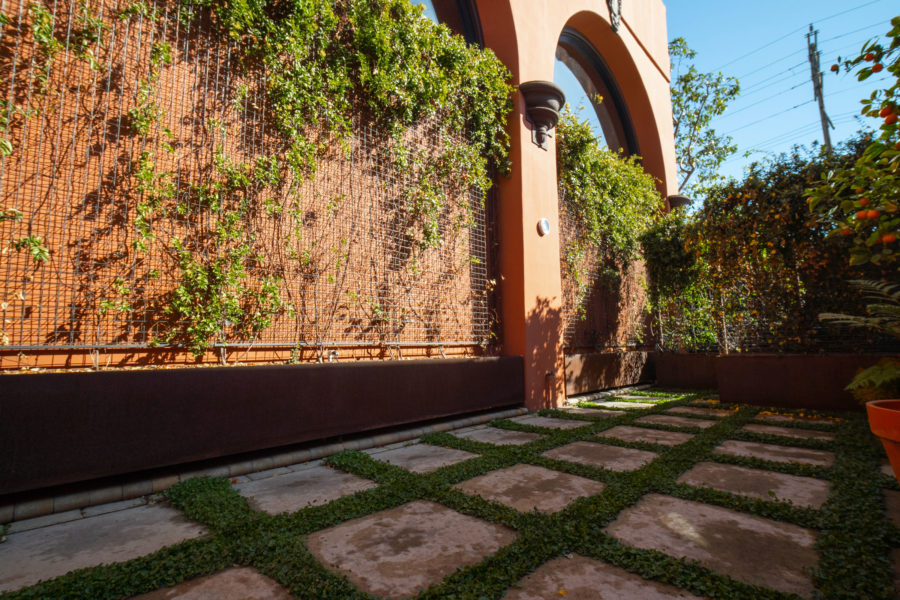
Chesterfield Square, South Los Angeles. Photo courtesy of greenscreen
Here we explore green roofs, walls, and facades.
A green or vegetated roof is essentially a roof with plants on it. There are many interesting new types of green roofs on the market. Some specialize in stormwater management, some simulate wetlands with remarkable biodiversity impacts, and others double as farms producing fruits and vegetables. Green roofs date back several thousand years, and their purposes were diverse, ranging from cooling to the production of produce, beautification, and more.
Both green facades and living walls are types of vertical greening. Direct green facades are attached to the wall from which the plants grow, while indirect green facades include a support structure for the plants that are offset from the wall. Plant trellis systems, such as from greenscreen, are examples of indirect green facades that allow climbing plants to cover the wall without damaging the facade. This simple and natural structure allows for building cooling, improved water cycling, increased biodiversity, reduced sound and air pollution, and beautification that may increase the property value.
Living walls have permeable screens into which plants are individually inserted. Living walls generally include more technology and installation efforts than green facades but can allow for more design freedom.
Where It Began
Green infrastructure has been an integral part of human settlements since the beginning of time—or at least since the Neolithic period. The first type of green roofs that we know of are sod roofs above caves, especially in the Norse countries. The sod provided insulation and protection against the elements.
The advanced culture of the Shang Dynasty in China developed literary gardens that provided shade and beautiful ecological havens within the cities for the aristocracy to enjoy.
This was only the beginning of the development of green infrastructure.
The Hanging Gardens of Babylon
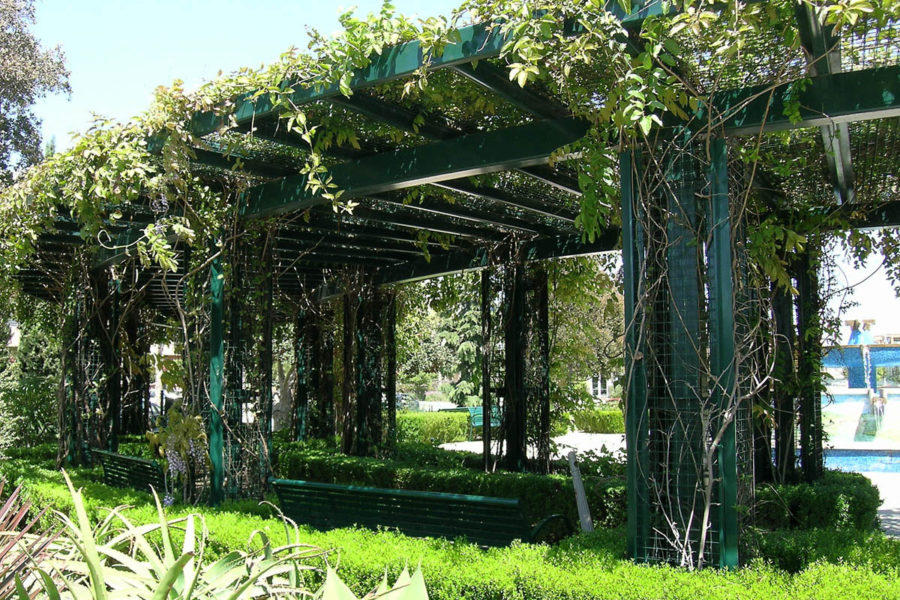
Fountain Park, Playa Vista, CA. Photo courtesy of greenscreen
The hanging gardens of Babylon (today’s Iraq) is one of the Seven Wonders of the Ancient World and the only one whose existence is disputed by some historians. They were said to be constructed around 600 to 500 BC. According to legend the gardens were a gift from Nebuchadnezzar II to his wife Amytis because she so sorely missed her home country Media’s lush greenery. While there is no direct evidence of the hanging gardens’ existence, archaeological records display spectacular engineering, including a depiction of a building with a built-in irrigation system.
Other archaeological finds like portrayals on relief panels (Ashurbanipal 668-631 BCE), point toward the existence of roof gardens in other places in ancient Mesopotamia like the ziggurats—large, stepped pyramid towers with planted trees and shrubs on flat terraces that provided cooling and shade for the inhabitants.
Greece
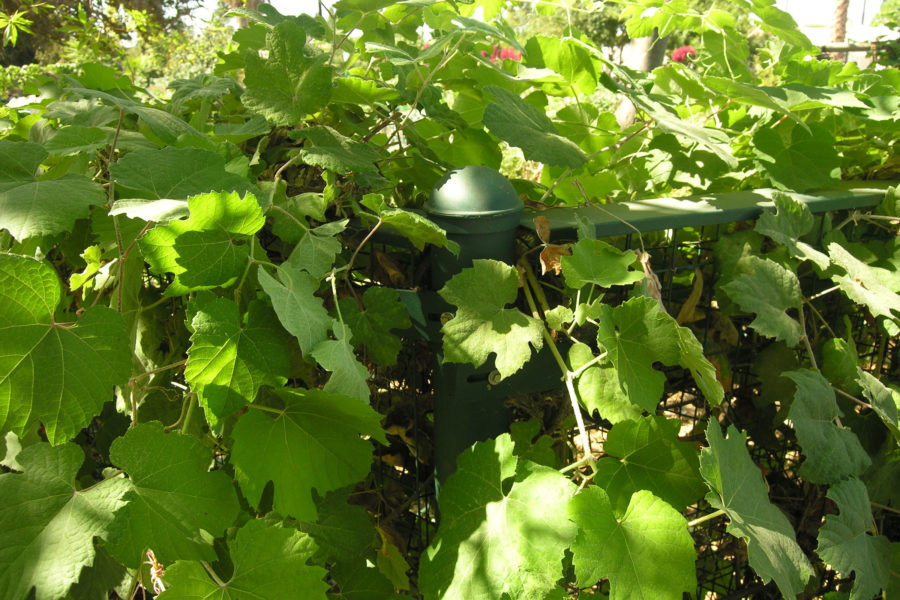
Grapevine Vitis californica. Photo courtesy of greenscreen
Ancient Greece was an early adopter of green infrastructure partly due to the hot climate and the Greek agoras, or open meeting spaces created for public discourse and interactions. The addition of vegetation to these spaces allowed for cooling and beautification, likely stimulating conversations. Imagine Plato and Aristotle walking in the cool shade, engrossed in deep conversation. Interestingly, modern research has shown people perform better at work in the presence of green infrastructure.
We should also not forget that the Greeks loved their wine and had a thriving wine industry. Due to the climbing properties of the grape vines these plants had multiple uses. They were grown horticulturally, but they also doubled as beautiful shade providers. Wine, beauty, and shade are three outstanding ecosystem services.
The Romans
The Romans took roof gardening to another level; they planted trees on institutional buildings and even imported some of them, which was a massive undertaking. Furthermore, the Roman botanist Theophrastus writes about using Sempervivum (a close relative to Sedum) on roofs and walls. Today sedum plants are one of the most used plant types on extensive green roofs.
The remnants of the Villa Dei Misteri (Villa of the Mysteries) in Pompei indicate not only an intensive roof garden but also a green facade. Furthermore, Emperor Charlemagne later declared that at least one plant had to be grown on every roof as the plants were believed to protect against lightning strikes and fires. Though a peculiar line of argumentation, it is still interesting to see how green infrastructure was so critical to their lives that the Emperor legislated around it.
Vikings and Soddies
Meanwhile, as China, Mesopotamia, and Southern Europe excelled in architecture, mathematics, philosophy, and innovation, my northern forbearers had to adapt green roofs for a cold climate. The roofs and walls of the Viking longhouses in today’s Denmark, Sweden, Norway, Greenland, Iceland, the Faroe Islands, and Vinland (today’s North America) were layered with inverted sod (the inversion reduced leakage), which insulated against the cold.
Layered birch bark was used as further waterproofing, with wooden beams and roof boards supporting the structure. On top of this sod sandwich plants were placed, commonly grasses, which held the sod in place through their extensive root systems. The sod roof tradition continued and was virtually universal until the 18th century in rural areas. In this part of the world, it is possible to see sod roof houses still, and this type of green infrastructure is deeply ingrained in the culture.
However, sod houses are not limited to the Norse countries but are also essential parts of US settlement history. In 1862 the Homestead Act was passed by the US Congress, which stated that a 160-acre plot would be given to settling families after five years, provided they would build a house and dig a well. Because of the green roof sod houses that often were constructed, these settlers were referred to as Soddies.
The Middle Ages and the Renaissance
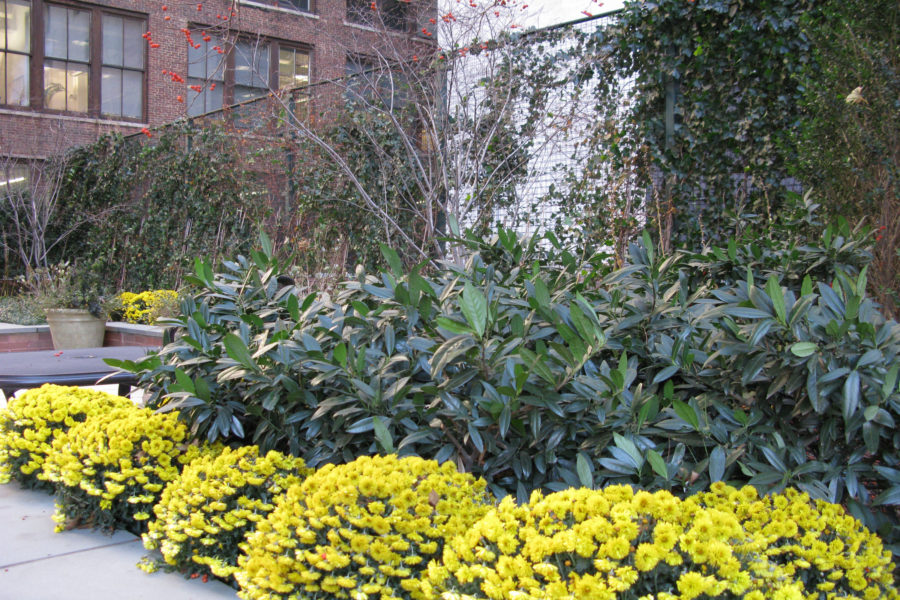
Vanguard Chelsea, New York, NY. Photo courtesy of greenscreen
Back in Southern Europe steeply terraced gardens, green facades, and green roofs were common during the Middle Ages and the Renaissance. However, the gardens were almost exclusively owned by the rich or Benedictine monks. This discrepancy in green infrastructure accessibility is still an issue today; studies have shown that low-income areas have lower access to green spaces and are exposed to higher levels of pollutants and poor sound environments.
17th Century France
French 17th century urban living conditions were, for the most part, terrible, which led the wealthy to create lush gardens and promenades that would separate them from the common folks. These promenades became a symbol of power and achievement amongst the French aristocracy; those who could afford nature were rich and powerful.
Despite this unequal general approach to green infrastructure, there were also constructions of large spaces within the cities to provide areas for social interactions, allowing for growing plants and crops for food close to the inhabitants.
US Innovators and Environmentalists
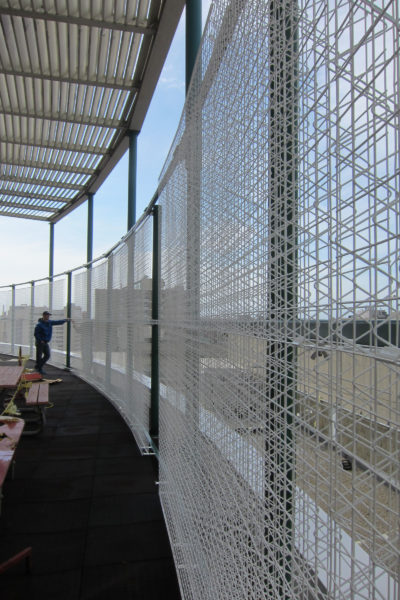
Tuft Medical Center in Boston. Photo courtesy of greenscreen
The environmental movement gained momentum in the 19th century with many novel thoughts around conservation and the human need for access to greenery. George Perkins Marsh, a diplomat considered by many to be the first American environmentalist, spoke in the mid-19th century about the irreversible impact of man’s actions on Earth and especially regarding deforestation. In 1860 Henry David Thoreau, American philosopher, poet, and environmental scientist, followed suit and said, “I think every town should have a park.” This eventually led to incredible developments in the US related to parks and urban development.
Famous landscape architect Frederick Law Olmsted followed in their footsteps and continued to develop the ideas and planned many parks and other types of green infrastructure in the US, most famously the Emerald Necklace in Boston and Brookline—1,100 acres of interconnected parks and waterways.
Many of the industrial leaders of the time were very positive toward green infrastructure developments, as they had recognized that worker output increased if the workers had access to green infrastructure.
Modern Green Infrastructure
The first green wall system was developed by Professor Stanley Hart White of the University of Illinois, who patented his “botanical bricks” in 1938. The system allowed for a quick buildup of greened structures. However, it would take a few more years before similar ideas took flight. Today the French botanist Patrick Blanc is considered the modern father of the vertical garden after his hugely successful installation of the massive living wall at the Museum of Science and Industry in Paris in 1986. Blanc has truly inspired novel green wall innovations around the world.
Modern green roof technology has its origins in Germany in the 1960s, but there are still functional green roofs built before the 1960s. One example is the Rockefeller Center green roof in NYC constructed in 1931.
Research was carried out (mainly in Germany and Switzerland) on green roof root repellents, waterproofing membranes, and lightweight media in the ’60s and ’70s. This intense work resulted in rapidly expanding (15 to 20% average growth per year) the green roof market in the 1980s. This expansion led to more technological developments, which allowed for lower loads and allowed green roofs to expand to more building types.
Trellis systems have also been developed over the past decades, on which climbing plants are allowed to grow, providing essential ecosystem services for the building and the surrounding area without direct attachment to the building facade.
Conclusion
If we look at the long history of green infrastructure, it is clear humanity needs access to greenery. We need the ecosystem services provided, and we need GI for our health and well-being. Imagine a building encased in honeysuckle and ivy—the shade it provides, the beauty, the calm, and the scented fresh air. It is not complicated to make this happen for a greener world.

